Abstract
BACKGROUND: The relative proportions of fibrosis and inflammation seen by open lung biopsy examination is a predictor of disease outcome in fibrosing alveolitis. This study was designed to assess the ability of high resolution computed tomography to predict the histological appearance of open lung biopsy specimens from patients with systemic sclerosis. METHODS: Twenty abnormal biopsy specimens from 12 patients were assessed; abnormalities were categorised as fibrotic (fibrosis exceeding inflammation) or inflammatory (inflammation equal to or exceeding fibrosis). Computed tomography appearances were scored for the lobe from which the biopsy specimen was taken; scans were graded from parenchymal opacification alone through to a reticular pattern alone. RESULTS: Two lobar appearances were identified on computed tomograms: amorphous parenchymal opacification equal in extent to reticulation (grade 3) and a predominantly reticular pattern (grade 4). There was a significant association between a fibrotic histological appearance and a grade 4 computed tomogram, and between an inflammatory histological appearance and a grade 3 computed tomogram. Computed tomography grade 4 was associated with a fibrotic histological appearance in 12 out of 13 lobes, and grade 3 with an inflammatory histological appearance in four out of seven lobes. CONCLUSION: Computed tomography discriminated between biopsy specimens that were predominantly fibrotic and a smaller group with a larger amount of inflammation.
Full text
PDF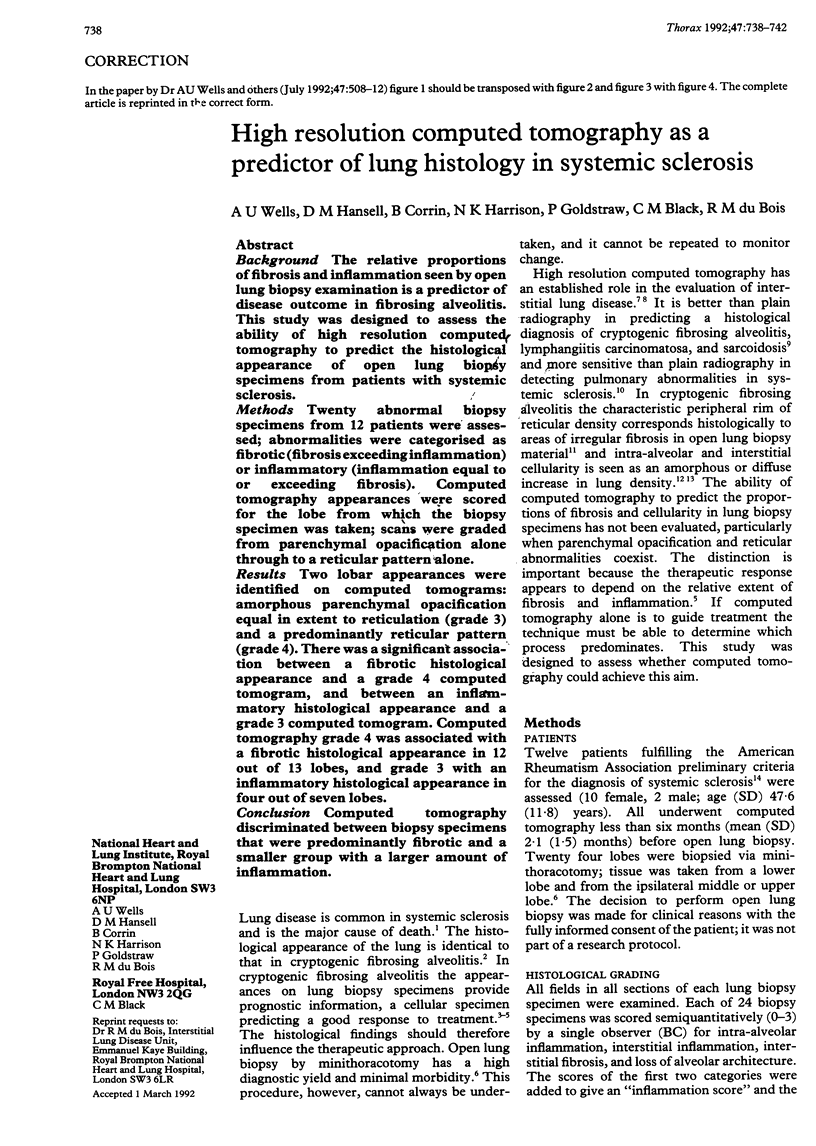
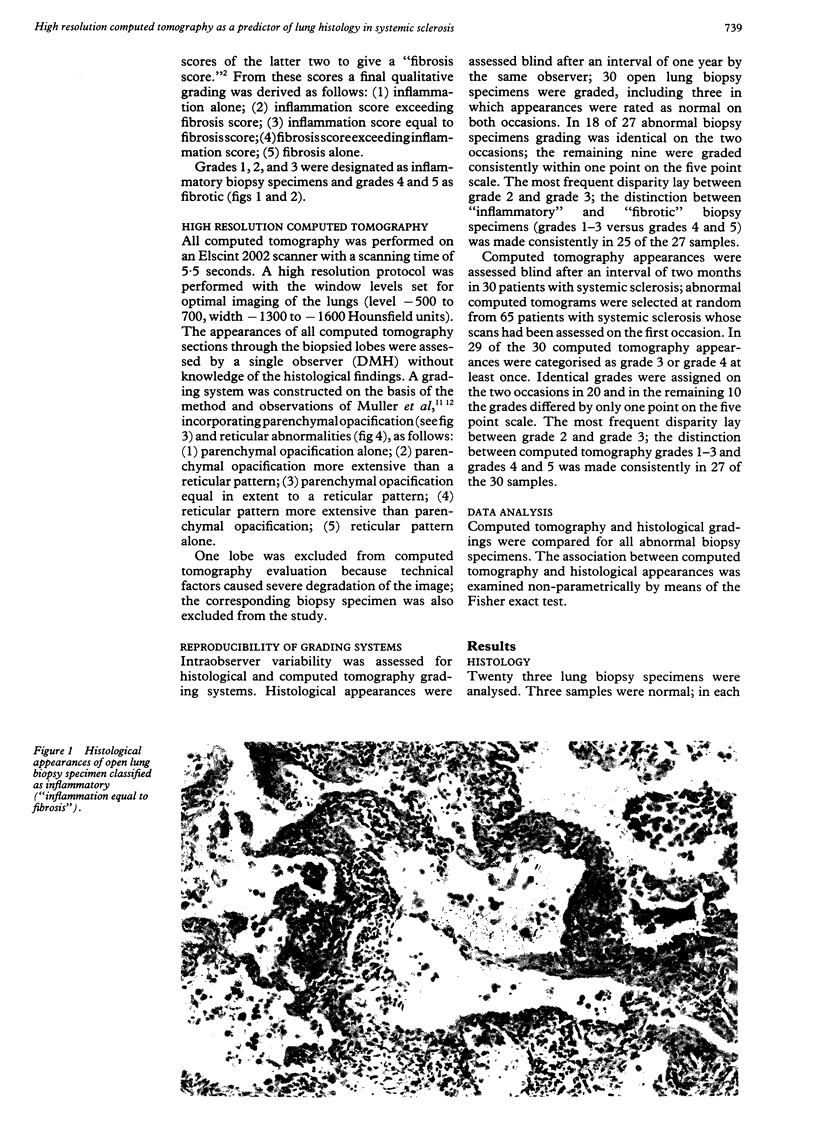
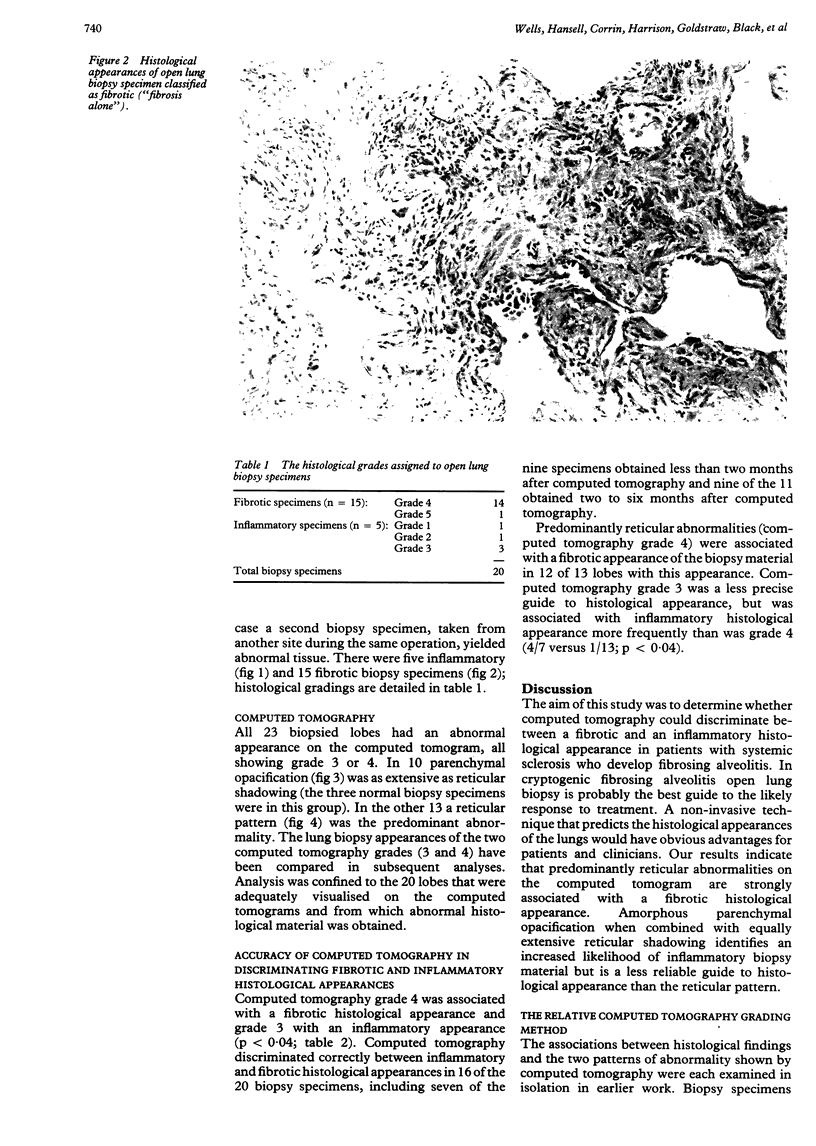
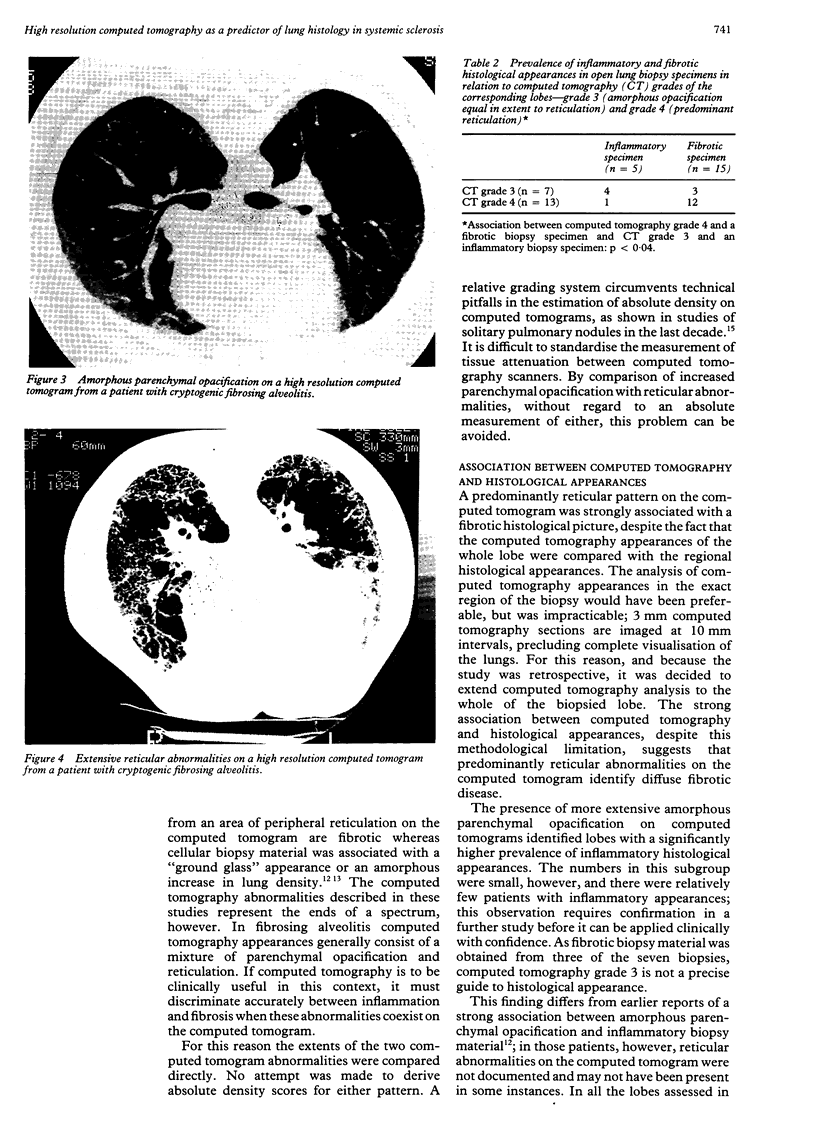
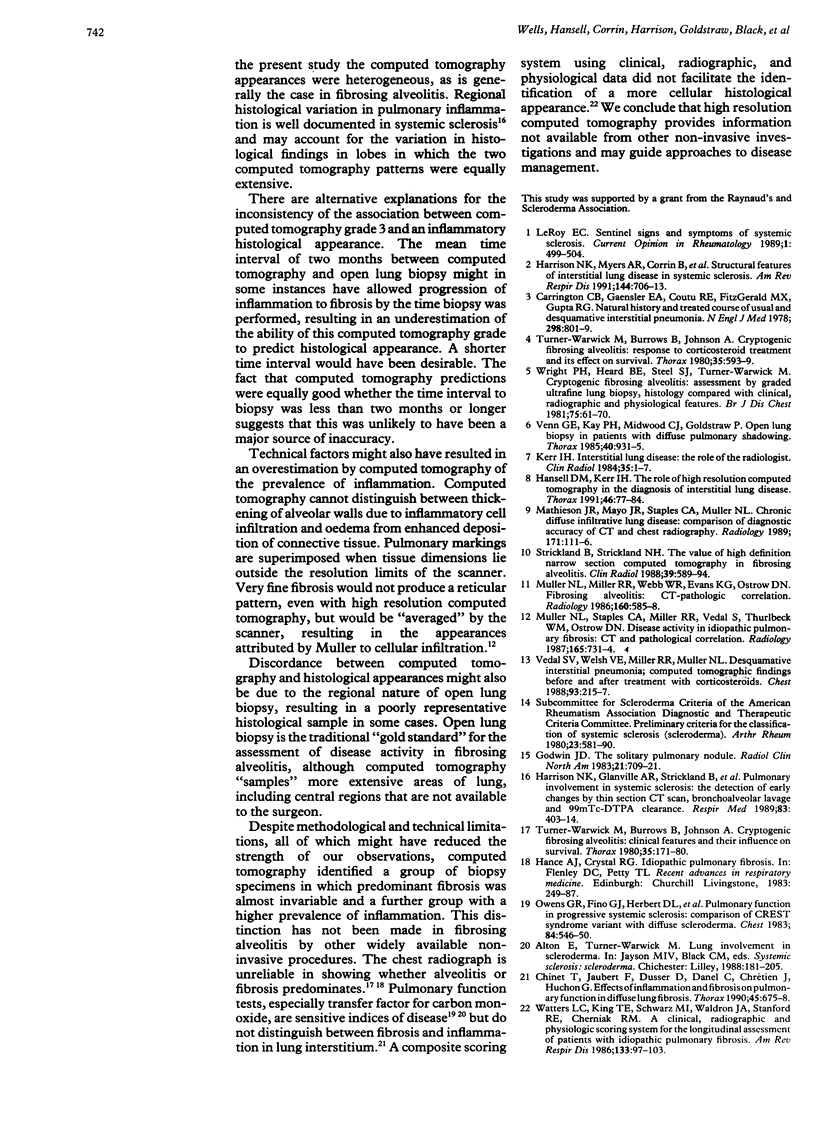
Images in this article
Selected References
These references are in PubMed. This may not be the complete list of references from this article.
- Carrington C. B., Gaensler E. A., Coutu R. E., FitzGerald M. X., Gupta R. G. Natural history and treated course of usual and desquamative interstitial pneumonia. N Engl J Med. 1978 Apr 13;298(15):801–809. doi: 10.1056/NEJM197804132981501. [DOI] [PubMed] [Google Scholar]
- Chinet T., Jaubert F., Dusser D., Danel C., Chrétien J., Huchon G. J. Effects of inflammation and fibrosis on pulmonary function in diffuse lung fibrosis. Thorax. 1990 Sep;45(9):675–678. doi: 10.1136/thx.45.9.675. [DOI] [PMC free article] [PubMed] [Google Scholar]
- Godwin J. D. The solitary pulmonary nodule. Radiol Clin North Am. 1983 Dec;21(4):709–721. [PubMed] [Google Scholar]
- Hansell D. M., Kerr I. H. The role of high resolution computed tomography in the diagnosis of interstitial lung disease. Thorax. 1991 Feb;46(2):77–84. doi: 10.1136/thx.46.2.77. [DOI] [PMC free article] [PubMed] [Google Scholar]
- Harrison N. K., Glanville A. R., Strickland B., Haslam P. L., Corrin B., Addis B. J., Lawrence R., Millar A. B., Black C. M., Turner-Warwick M. Pulmonary involvement in systemic sclerosis: the detection of early changes by thin section CT scan, bronchoalveolar lavage and 99mTc-DTPA clearance. Respir Med. 1989 Sep;83(5):403–414. doi: 10.1016/s0954-6111(89)80072-1. [DOI] [PubMed] [Google Scholar]
- Harrison N. K., Myers A. R., Corrin B., Soosay G., Dewar A., Black C. M., Du Bois R. M., Turner-Warwick M. Structural features of interstitial lung disease in systemic sclerosis. Am Rev Respir Dis. 1991 Sep;144(3 Pt 1):706–713. doi: 10.1164/ajrccm/144.3_Pt_1.706. [DOI] [PubMed] [Google Scholar]
- Kerr I. H. Interstitial lung disease: the role of the radiologist. Clin Radiol. 1984 Jan;35(1):1–7. doi: 10.1016/s0009-9260(84)80214-7. [DOI] [PubMed] [Google Scholar]
- LeRoy E. C. Sentinel signs and symptoms of systemic sclerosis. Curr Opin Rheumatol. 1989 Dec;1(4):499–504. doi: 10.1097/00002281-198901040-00014. [DOI] [PubMed] [Google Scholar]
- Mathieson J. R., Mayo J. R., Staples C. A., Müller N. L. Chronic diffuse infiltrative lung disease: comparison of diagnostic accuracy of CT and chest radiography. Radiology. 1989 Apr;171(1):111–116. doi: 10.1148/radiology.171.1.2928513. [DOI] [PubMed] [Google Scholar]
- Müller N. L., Miller R. R., Webb W. R., Evans K. G., Ostrow D. N. Fibrosing alveolitis: CT-pathologic correlation. Radiology. 1986 Sep;160(3):585–588. doi: 10.1148/radiology.160.3.3737898. [DOI] [PubMed] [Google Scholar]
- Müller N. L., Staples C. A., Miller R. R., Vedal S., Thurlbeck W. M., Ostrow D. N. Disease activity in idiopathic pulmonary fibrosis: CT and pathologic correlation. Radiology. 1987 Dec;165(3):731–734. doi: 10.1148/radiology.165.3.3685351. [DOI] [PubMed] [Google Scholar]
- Owens G. R., Fino G. J., Herbert D. L., Steen V. D., Medsger T. A., Jr, Pennock B. E., Cottrell J. J., Rodnan G. P., Rogers R. M. Pulmonary function in progressive systemic sclerosis. Comparison of CREST syndrome variant with diffuse scleroderma. Chest. 1983 Nov;84(5):546–550. doi: 10.1378/chest.84.5.546. [DOI] [PubMed] [Google Scholar]
- Strickland B., Strickland N. H. The value of high definition, narrow section computed tomography in fibrosing alveolitis. Clin Radiol. 1988 Nov;39(6):589–594. doi: 10.1016/s0009-9260(88)80056-4. [DOI] [PubMed] [Google Scholar]
- Turner-Warwick M., Burrows B., Johnson A. Cryptogenic fibrosing alveolitis: clinical features and their influence on survival. Thorax. 1980 Mar;35(3):171–180. doi: 10.1136/thx.35.3.171. [DOI] [PMC free article] [PubMed] [Google Scholar]
- Turner-Warwick M., Burrows B., Johnson A. Cryptogenic fibrosing alveolitis: response to corticosteroid treatment and its effect on survival. Thorax. 1980 Aug;35(8):593–599. doi: 10.1136/thx.35.8.593. [DOI] [PMC free article] [PubMed] [Google Scholar]
- Vedal S., Welsh E. V., Miller R. R., Müller N. L. Desquamative interstitial pneumonia. Computed tomographic findings before and after treatment with corticosteroids. Chest. 1988 Jan;93(1):215–217. doi: 10.1378/chest.93.1.215. [DOI] [PubMed] [Google Scholar]
- Venn G. E., Kay P. H., Midwood C. J., Goldstraw P. Open lung biopsy in patients with diffuse pulmonary shadowing. Thorax. 1985 Dec;40(12):931–935. doi: 10.1136/thx.40.12.931. [DOI] [PMC free article] [PubMed] [Google Scholar]
- Watters L. C., King T. E., Schwarz M. I., Waldron J. A., Stanford R. E., Cherniack R. M. A clinical, radiographic, and physiologic scoring system for the longitudinal assessment of patients with idiopathic pulmonary fibrosis. Am Rev Respir Dis. 1986 Jan;133(1):97–103. doi: 10.1164/arrd.1986.133.1.97. [DOI] [PubMed] [Google Scholar]
- Wright P. H., Heard B. E., Steel S. J., Turner-Warwick M. Cryptogenic fibrosing alveolitis: assessment by graded trephine lung biopsy histology compared with clinical, radiographic, and physiological features. Br J Dis Chest. 1981 Jan;75(1):61–70. doi: 10.1016/s0007-0971(81)80008-3. [DOI] [PubMed] [Google Scholar]






